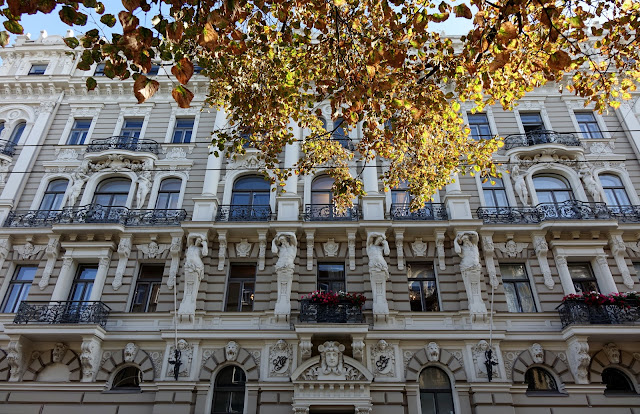Riga, Latvia
I was excited to arrive at the architecturally bejeweled town of Riga, the capital city of Latvia called the Paris of the Baltic and designated as the European Capital of Culture for 2014. Our guided tour of the city was not scheduled until the next day. After a quick change of clothes, I walked to Vermanes Park across the hotel and spent my free time observing the locals. On the benches of an open concert stage, I saw young men stretching and using the benches as an obstacle course for their late afternoon workout (I’d guessed). Glad that I was not tempted to get ice-cream from the bright pink colored ice-cream place around the corner, offering tubs of ice-cream and cookies before dinner because I was looking forward to having Latvian food for dinner. In the short time I spent in the park, I found Riga to be a lively, beautiful and very safe-feeling city.
I then met up with the group and walked to “Alkimikis” brewery/restaurant, housed at an old wooden building but with a modern interior. The ambiance and food presentation at the beer house/restaurant was great. My soup and salad were good, but my main course of beef roll with sweet potato puree was a disappointment. The lunch I had from Lido, a fast-food buffet restaurant, was much better.
The following morning, we started the walking tour to see the most famous Art Nouveau buildings in Riga. It’s said that Art Nouveau architecture makes out roughly one-third of all buildings in the center of Riga, making it the city with the highest concentration of Art Nouveau architecture anywhere in the world. We walked along Albert Street and focused on the buildings designed by Mikhail Eisenstein.

The Old Town was a few blocks from the Art Nouveau neighborhood. It features over 500 buildings built in various architectural styles - Romanticism, Gothic, Baroque, Modernism, etc. Strolling through the cobblestones was like walking into an open-air museum where the architecture chronicles the city’s complicated history from the 12th century Dome cathedral to the 14th-century Guildhall, to the brick tower built by the 17th century ruling Swedes.
St. Peter’s Church is the oldest in the city and the main landmark of Riga. It’s one of the most important buildings in the middle ages, and associated with three different periods; Gothic, Romanesque and Baroque. When the church tower collapsed, Peter the Great had it rebuilt.

We turned a corner and found the 14th-century merchant guild hall with an elaborate Dutch Renaissance façade. It was destroyed during WWII and rebuilt after Latvia regained its independence.
 |
| The House of Blackheads |
 |
| The Three Brothers are the oldest medieval dwelling houses in Riga. In the medieval times, Maza Pils Street was located in the outskirts of Riga and craftsmen lived there. |

The Swedish Gate is the only surviving city gate of Riga, which was built into the city wall in 1698 during Swedish rule.
 |
| The Museum of Foreign Art |
The UNESCO plaque displaying Riga's inscription can be found just in front of the Evangelical Lutheran cathedral of Riga in Cathedral Square.
 |
| Romantic Cobblestone Lane |
 |
| The buildings varied and constructed during different periods of history |
 |
| The Soviet Occupation Exhibition |
After the guided tour, my co-traveler and I continued to explore and take photos of the area along the river, park, and asphalt boulevards.
 |
| Bastejkalns Park |
The Riga Radio and TV Tower is the tallest tower in the European Union. It was built between 1979 and 1989 with funding from the central government of the Soviet Union.
 |
| The Railway Bridge and Riga Radio and TV Tower |
 |
| Riga's Skyline of Gothic spires in the Old Town backdropped by beautiful clouds. |
NOTE: All photos by the author




You made some decent points there. I looked on the web for the problem and located most people is going coupled with with the web site. http://attemustonen.com/auschwitz-tour-and-my-visit-in-krakow/
ReplyDelete